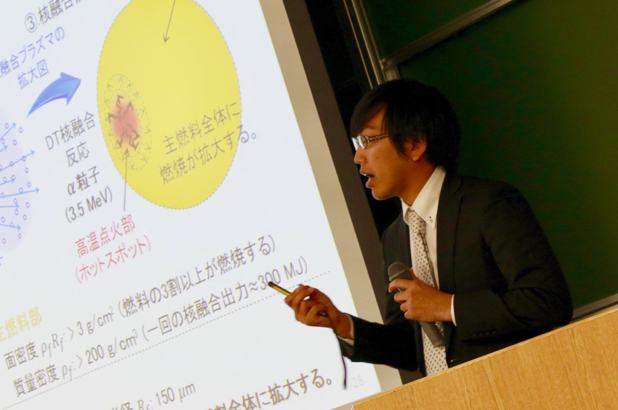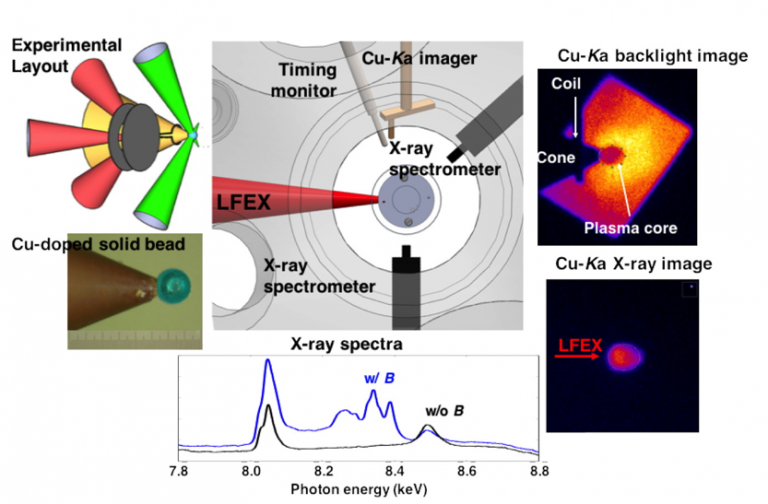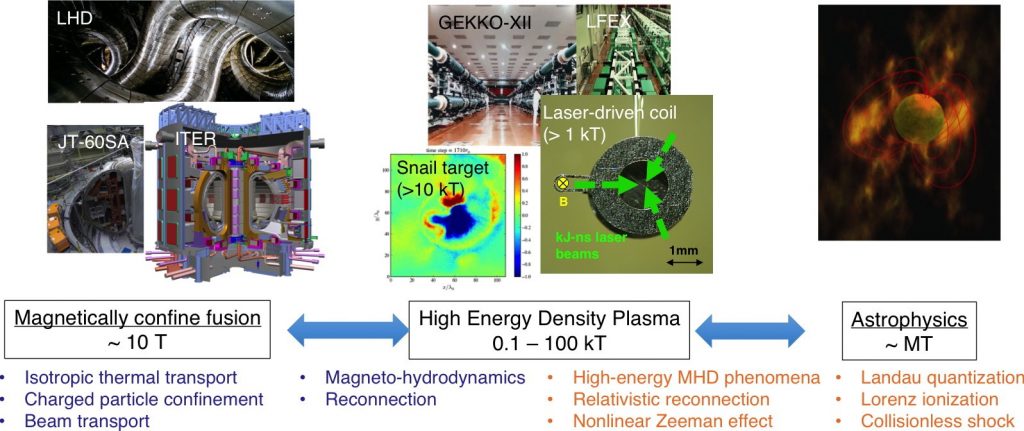Laser-produced-high-Field sciences (LF)
Summary
We are in a cooperative group of the Department of Physics, Graduate School of Science, The University of Osaka. We belong to the elementary particle and nuclear physics experiment groups in the Department of Physics. We are in charge of high-energy-density-plasma sciences and laser fusion plasma research using ultra-high-intensity electric field, magnetic field, radiation field etc. generated by high-energy and high-intensity laser.
One of our research pillars is fast heating of laser fusion fuel with ultra-high-intensity laser pulse. In this fast-ignition method studied at our institute, we use a factory-sized GEKKO-XII and LFEX laser facilities to compress fusion fuel to high density and to heat instantaneously the compressed fuel with a high intensity laser. For heating the fusion fuel up to over 50 million degrees of the fusion ignition threshold temperature, we must handle the phenomenon governed by combination of the electromagnetic fields generated by microscale and macroscale plasma dynamics and the turbulent electromagnetic field structure formed by interference between the incident and reflected laser fields. Using high-quality experiments and precise simulations, we will understand the essential fundamentals of this complex phenomenon and proceed toward achieving the goal.
In addition, we are developing new fields of ultra-high intensity field science and extreme plasma sciences, such as laboratory astrophysics by using high intensity field, nuclear science etc, for example, laboratory measurement of photoionization plasma phenomena observed around black hole, measurement of electric properties of warm dense matter, formation of a collisionless shock , relativistic magnetic field reconnection, ultra high density compression of material by tailored and sequential shock waves and hydrodynamic instability associated with the compression, nuclear reaction measurement occurring inside high-energy-density plasma, We will actively challenge interesting and important topics in the wide variety of high-energy-density physics.
We believe that recreation is also important. Please visit the group’s website looking at recent activities.

Picture 1 Ph. D defense presentation

Picture 2 Farewell party held in March 2017 after an annual meeting of Japanese Physical Society
Facilities
- Japan No.1 largest TW laser GEKKO-XII
- World No. 1 largest PW laser LFEX
- Large Computor NEC SX-ACE Lite
Research collaboration
Institute of Laser Engineering of The University of Osaka, as a joint research and collaborative research center on laser energy science, conducts a lot of joint research with many organizations both in Japan and abroad.
Regarding ultrahigh-field science, we are conducting joint research with the National Institute for Quantum and Radiological Science and Technology (QST), Kyushu University, Hiroshima University and others. Regarding the fast ignition laser fusion, we are conducting bilateral collaborative research with the National Institute for Fusion Science (NIFS), Hiroshima University, Tohoku University, Nagaoka University of Technology and others.
Collaboration with foreign countries includes the Lawrence Livermore National Laboratory, the University of Rochester, the University of Nevada, Reno, the University of California, San Diego, the University of Texas at Austin in the United States; the Rutherford Institutes in the UK; the Ecole Polytechnique and the University of Bordeaux in France; Spain’s Universidad Politecnica de Madrid; Germany’s Technische Universitat Dresden; Russia’s National Research Nuclear University; Moscow Engineering and Physics Institutes in Russia; Chinese Academy of Sciences, China National Astronomical Observatory; Korean Atomic Energy Research Institute and others. Students also participate in overseas joint experiments.

Picture 3 Discussion for collaboration research in Moscow

Picture 4 Two students joined in the collaboration experiment held in Ecole Polytechnique in France.
Research topics
1. Plasma heating with high-intensity laser for nuclear fusion application
High energy electrons and ions are generated by the interaction between plasma and ultra-high intensity laser exceeding Peta-Watt. We are try to understand and control their generation, transport and energy dissipation in the plasmas. Our mission is to demonstrate plasma heating up to 50 million degrees that is the threshold temperature of the fusion ignition. As a control method, we will proactively introduce new ideas, such as plasma mirrors, kilo-Tesla magnetic fields, etc.

Figure 1 Schematic view of the fast ignition laser fusion experiment.
2. Extreme plasma physics
We will create a wide range of high energy density plasmas to study pioneering extreme plasma physics such as relativistic plasma,high temperature and high density plasmas, warm dense matter by introducing various laser technologies and novel targets. We will study hydrodynamics, energetic radiation and particle generation, nuclear reaction etc. in the extreme plasma. This research may reproduce the physical phenomena occurring in the interior of a star and/or around a high energy astronomical objects in a laboratory and understand its physical process by laboratory experiment.

Figure Span of plasma physics with high-intensity magnetic field.
3. Extreme Plasma Diagnostics
Precise measurement technology development is necessary for precise experiments. Hard X-ray spectrometer using Compton scattering phenomenon, X-ray spectrometer using hard X-ray and photonuclear reaction of matter, radiography of high density plasma using X-ray pulse of about 1 picosecond, relativistic We are developing transport propagation measurement method using coherent synchrotron radiation from electrons, electromagnetic field measurement using laser accelerated proton, and so on.

Figure 3. Electric and magnetic fields measurement with laser-accelerated proton beam.
Member
| FUJIOKA Shinsuke | Professor |
| MIYAMOTO Shuji | Specially Appointed Professor |
| TANAKA Nozomi | Specially Appointed Associate Professor (Lecturer) |
| Law King Fai Farley | Specially Appointed Assistant Professor |
| Hernandez James Edward II Aquino | Specially Appointed Researcher |
| NISHIHARA Katsunobu | Guest Professor/Professor Emeritus |
| AZECHI Hiroshi | Guest Professor/Professor Emeritus |
